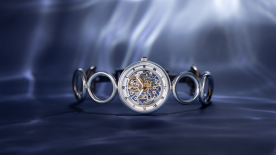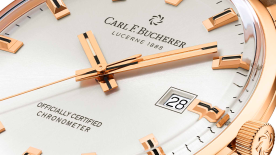Every brand wants a flagship product, its “icon”: the Royal Oak at Audemars Piguet, the Reverso for Jaeger-LeCoultre or Hublot’s Big Bang. Louis Moinet’s flagship is, beyond any doubt, the Memoris; a superb contemporary interpretation of the chronograph from a workshop named after none other than the chronograph’s inventor, in 1816.
Over time, the Memoris has grown, evolving without ever departing from its fundamental nature. This is the art of Jean-Marie Schaller, the brand’s founder, and the delicate mission that now falls to the Impulsion.
An indirect descendent
This new watch doesn’t claim to be a Memoris. Could it anyway? To each their own opinion, although the chronograph’s position on the dial side - a powerful aesthetic marker - is a strong indication. This complication reveals all across the entire upper portion of the dial, which becomes a captivating choreography of bridges, cams and levers.
The composition still carries the same depth and craftsmanship, elevated by a level of finishing that signifies both excellence and modernity. The emblematic column wheel at 12 o’clock warrants special appreciation; a fioritura in this perfectly orchestrated mechanical symphony.
While these may be familiar notes, they form a new score. The subdial for the time at 6 o’clock has gone, replaced by central hour and minute hands which join the chronograph seconds hand. In all, a fairly traditional bicompax layout.
Far less traditional are the Impulsion’s specially created hands. Gilded, they have no difficulty standing out on the dial for easy readoff of hours and minutes. Openworked, they don’t impose their presence. They are sleek and contemporary. Note also the lovely terminal curvature of the central seconds hand that mirrors the sapphire crystal’s glassbox-like curve.

Breguet x Moinet
The 6 o’clock position is reserved for a complication that Louis Moinet has never previously combined with a chronograph, namely a tourbillon (specifically a flying tourbillon, one that has no upper bridge). It’s an amusing historical reference, knowing that Breguet, the inventor of the tourbillon, worked with Moinet, the inventor of the chronograph. The two functions have been seen together before (including several times by Breguet) but for Louis Moinet, this is a first.
The tourbillon in question is executed with the same modern, incisive language as the rest of the watch. A large opening exceeds that of the chronograph counters: the noble escapement is here to be seen. It is the work of Concepto in La Chaux-de-Fonds, Louis Moinet’s longstanding partner that already worked on the brand’s first tourbillons (Vertalis and Vertalor), and reprises the same open, demonstrative aesthetic grammar.

Well within reason
At 42.5mm the Impulsion’s diameter is more than reasonable, in view of all it contains: both complications in addition to the twin barrels that replace the Memoris’s single barrel. This doubling-up translates into a longer power reserve which, for the manually-wound Impulsion, extends to four days (96 hours).
A last word for the case which was created specifically for the Impulsion using the Neo as a starting point, but with a sharper, more overtly modern design. It holds a container in titanium with a blue or black treatment, depending on whether the base plate is black or aventurine. Louis Moinet will produce 28 of each variant, cased in pink gold and titanium.





